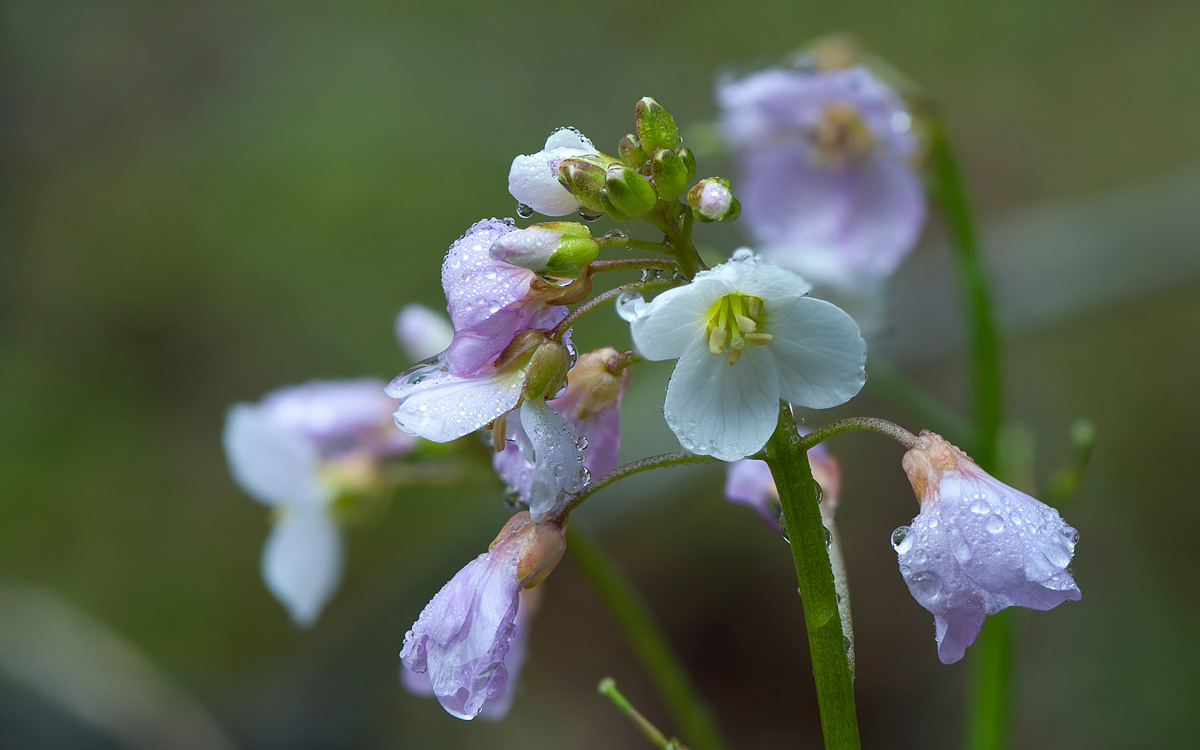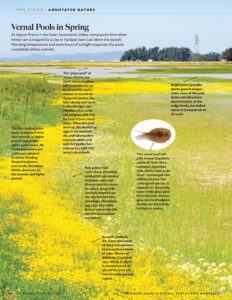While transplanted New Englanders may complain about the Bay Area’s inconspicuous seasons, true Californians prefer February flowers to snow shovels. What we lack in extremes we make up in subtle and unexpected beauty.
A winter walk in Bay Area wildlands reveals a quiet season of renewal as plants are awakened from the torpor of summer drought by the return of the rains. New grass shoots and mosses cover ground, rock, and trunk with photosynthetic green, and woody plants refresh while they wait for the longer days and warmer weather of spring to bloom. Yet within this green landscape of winter, there are floral surprises. On rocky ridges and canyons clothed in chaparral, tight clusters of white or pink manzanita flowers hang on branch ends for weeks and show off against rain-slick burgundy bark and dense green foliage. Even on the ground, the spent blossoms light up landscapes, collecting in graceful wind-raked drifts that look like dustings of snow.
But flowers are delicate things, and even with the Bay Area’s temperate coastal climate, winter is still a hard time for a plant to bloom. The relative scarcity of pollinators in winter can thwart reproduction, the flowers’ raison d’etre. And exposed pollen can be squandered in foul weather–washed out of one flower, never to reach another. So plants that bloom early are challenged to protect their reproductive parts from the elements but still attract pollinators.
Manzanita flowers do this with waxy petals fused into tiny upside-down urns that open between November and February depending on species and locale. The petals form a protective sheath over stamens and stigma but still provide an entrance for bees, hummingbirds, and early butterflies that sip nectar and pollinate the flowers.
Even more shielded from winter weather are California pipevine flowers (Aristolochia californica), which bloom like miniature meerschaum pipes on leafless stems in woodlands, chaparral, and streamside habitats beginning in February. Tiny gnats follow the pipevine flower’s carrion-like odor through a narrow maroon opening at the bowl end of the pale green pipe. Once inside, they’re disoriented by light flooding through the flower’s translucent walls, and they can’t find the exit. But the flower provides nectar to its captives, and they in turn transfer pollen as they move around inside. After a few days, the pollinated flower’s opening droops and the gnats escape.
Another very early bloomer appears in shady woodland habitats as early as January. The open saucers of milk-white petals that make milk maids (Cardamine californica) so noticeable could also expose their pollen to the weather. But the flowers bow their heads in the rain and furl their petals into protective tubes at night.
For plants dependent on animals for pollination, blooming early means fewer pollinators. Only one hummingbird species, Anna’s, overwinters here. Adult native bees are long dead, with the next generation ensconced underground until spring. Honeybees huddle in their hives to stay warm at temperatures below 57 degrees, and the few butterflies that seek flowers in January or February can do so only on sunny days when they can absorb enough warmth to fly. Plants that bloom when pollinators are scarce often do so over long periods, and individual flowers may stay fresh for weeks.
For insects and hummingbirds that fly year-round, the sustenance provided by early-blooming flowers is critical to survival. And though they must expend more energy to warm up and find blooming plants in winter, the reward is often greater. With less competition, there’s less chance another pollinator has already extracted a flower’s nectar, so more nectar calories are available to replenish those expended in flight.
During the later weeks of winter, brightly colored flowers begin to appear. By early March, pink flowering currant shrubs (Ribes sanguineum var. glutinosum) bloom in many Bay Area parks and gardens, and azure-blue hound’s tongue flowers (Cynoglossum grande) appear in shady woodlands. As the equinox approaches, pollinators emerge and return, and the flower show expands into its rich spring abundance.
We’re fortunate that this mutualistic dance of flowers and pollinators begins very early in our part of the world, and those of us who are attuned to California’s subtle seasons know it’s really winter when the early bloomers appear.





